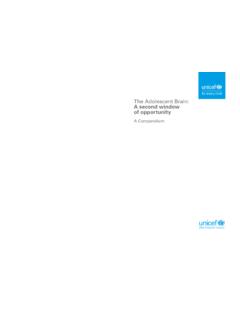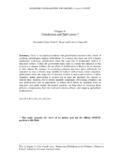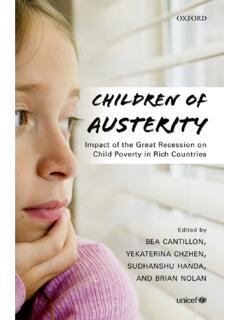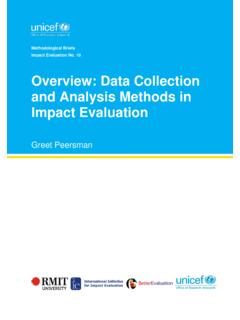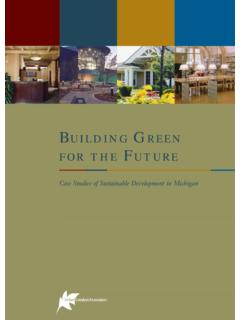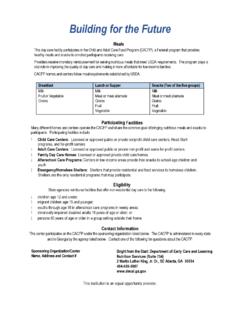Transcription of Children and the Sustainable - UNICEF-IRC
1 building the FutureChildren and the Sustainable Development Goals in Rich CountriesUNICEF Innocenti report Card 14 Children in the Developed WorldInnocenti report Card 14 was written by Chris Brazier. The UNICEF Office of Research Innocenti would like to acknowledge the generous support for report Card 14 provided by the Government of part of this Innocenti report Card may be freely reproduced using the following reference: UNICEF Office of Research (2017). building the future : Children and the Sustainable Development Goals in Rich Countries , Innocenti report Card 14, UNICEF Office of Research Innocenti, Florence. The Innocenti report Card series is designed to monitor and compare the performance of economically advanced countries in securing the rights of their 1988 the United Nations Children s Fund (UNICEF) established a research centre to support its advocacy for Children worldwide and to identify and research current and future areas of UNICEF s work. The prime objectives of the Office of Research Innocenti are to improve international understanding of issues relating to Children s rights, to help facilitate full implementation of the Convention on the Rights of the Child, supporting advocacy worldwide.
2 The Office aims to set out a comprehensive framework for research and knowledge within the organization, in support of its global programmes and policies. Through strengthening research partnerships with leading academic institutions and development networks in both the North and the South, the Office seeks to leverage additional resources and influence in support of efforts towards policy reform in favour of produced by the Office are contributions to a global debate on Children and may not necessarily reflect UNICEF policies or approaches. The views expressed are those of the Office of Research Innocenti receives financial support from the Government of Italy, while funding for specific projects is also provided by other governments, international institutions and private sources, including UNICEF National photo Shutterstock United Nations Children s Fund (UNICEF), June 2017 ISBN: 978-88-6522-050-4eISBN: 978-92-1-060790-2 ISSN: 2519-108X UNICEF Office of Research Innocenti Piazza SS.
3 Annunziata, 12 50122 Florence, ItalyTel: +39 055 2033 0 Fax: +39 055 2033 @UNICEFI nnocenti the FutureChildren and the Sustainable Development Goals in Rich Countries Innocenti report Card 14 Children in the Developed WorldIntroductionReport Card 14 This report Card offers an assessment of child well-being in the context of Sustainable development across 41 countries of the European Union (EU) and the Organisation for Economic Co-operation and Development (OECD). This group includes both high- and middle-income economies, but here we refer to them all as high-income countries or rich countries , for convenience. The concept of child well-being is rooted in the Convention on the Rights of the Child (CRC) but the Agenda for Sustainable Development adds new dimensions. Progress across all these dimensions will be vital to Children , and advanced economies will therefore need to monitor the situation of Children and young people both nationally and globally. The Sustainable Development Goals (SDGs) agreed by the international community in 2015 represent an ambitious effort to set a global agenda for development that is both equitable and Sustainable , in social, economic and environmental terms.
4 The earlier Millennium Development Goals (MDGs) prioritized the reduction of poverty, as well as progress in related social indicators. The 17 goals of the SDGs add to this a series of outcomes associated with inequality, economic development, the environment and climate change, as well as peace and security. In contrast to the MDGs, which primarily applied to low- and middle-income countries, the ambitious agenda of the SDGs is of necessity universal; it thus applies to rich countries, as well as poor. The stronger focus of the SDGs on equitable development and on leaving no one behind also demands attention to inequalities along multiple dimensions of income and wealth, health and educational opportunity, as well as voice and political participation both within and between countries. Addressing rising inequality and its related problems requires a focus not just on the conditions of the poorest, but also on the consequences of wealth accumulation by the richest.
5 As countries seek to meet the SDGs, so the changing political landscape will require new approaches to ensure inclusive and Sustainable outcomes. Long-term, inclusive and Sustainable social goals are best met through attention to the needs of Children . Ensuring the well-being and realizing the rights of all Children (including migrants and refugees) is not only a commitment made by those states that have signed the CRC, but is also an essential condition for achieving long-term development goals. Every high-income country invests in its Children : healthy, educated Children are better able to fulfil their potential and contribute to society. By contrast, problems of child development often carry through into adulthood, with the resulting social costs accruing to the next generation, too. Indeed, achieving the SDGs is about ensuring that future generations have the opportunities enjoyed by the present generation: successful outcomes for today s Children will build the foundations for the well-being of our societies to the SDGs made by governments now need to be The Sustainable Development Goals have set ambitious targets that apply to rich countries as well as poor.
6 The most telling sign of a nation s progress towards meeting those goals will be how well it meets the needs of its building THE FUTURE4 INNOCENTI report CARD 14translated into programmes and public investments that can deliver on this wide-ranging set of goals and their 169 accompanying targets. While many goals require commitment at the global or multilateral action level if they are to be achieved (particularly those associated with climate change and the global economy), they also demand national action. If countries are to be held to account for their progress towards these goals, appropriate indicators for monitoring that progress are necessary. UNICEF has long been at the forefront of global efforts to monitor life outcomes and social progress for Children , and it now plays a leading role in monitoring child-related SDG indicators (see Box 2: UNICEF s global role in SDG monitoring, page 6).Many of the SDG indicators proposed by the global community are most appropriate for lower-income contexts.
7 report Card 14 proposes an adapted set of indicators to assess countries performance against the promise of leaving no one behind when national circumstances, ambitions and existing levels of social progress are already well advanced (see Box on the right: How have report Card 14 indicators been selected?). Specifically, this report seeks to bring the SDG targets for Children in high-income countries into meaningful operation (while staying true to the ambitions of the global agenda) and to establish a point of departure for reviewing the SDG framework in these contexts. It focuses on those goals and targets with most direct relevance to the well-being of Children in high-income settings. Where appropriate, it adapts the agreed SDG indicator, the better to reflect the problems facing Children in such countries (see Table 1 pages 4-5). Although limited by the lack of comparable data in some domains, this report compares 41 countries across 25 indicators. As in other report Cards, countries are ranked on their achievements in well-being for Children according to the selected indicators.
8 The report Card cannot provide an in-depth analysis of the reasons behind differences, nor of the policy options available for making progress on selected indicators. Nonetheless, by illustrating variation along key dimensions of child well-being related to the SDGs from ending poverty to promoting peaceful and inclusive societies it suggests areas where policy efforts or public investment may be targeted to improve outcomes, and reveals where data inadequacies still need to be addressed. IntroductionIndicators for monitoring child-relevant SDGs in high-income countries were selected using the criteria listed below. Relevance: Does the indicator directly concern child well-being in high-income countries? Data availability and quality: Are high-quality data with adequate coverage available? Do they meet necessary standards regarding representativeness, comparability, accuracy and frequency of collection? Communicability: Is the indicator itself easily explained, conceptually clear, and do the reported figures clearly convey the extent of progress by country on a given target?
9 Policy attainability: Is progress on the indicator realistic, within the time frame of the SDGs? Alignment with global indicators: Is the indicator a good match to the proposed global indicator? Does it reflect the spirit and intent of the corresponding SDG goal and target?Extensive consultations with experts at meetings of the report Card Advisory Board composed of academics, independent experts, UNICEF national committee members and communications experts also informed the selection of indicators and established their conceptual : Bruckauf, Z. and Cook, S. (2017). Child-Centred Approach to the Sustainable Development Goals (SDGs) in High-Income Countries: Conceptual issues and monitoring approaches , Innocenti Working Paper 2017-06, UNICEF Office of Research Innocenti, 1 How have report Card 14 indicators been selected?INTRODUCTION building THE FUTUREINNOCENTI report CARD 145 GoalTarget (by 2030 unless specified) report Card 14 indicatorRelationship to SDG global indicators1 End poverty in all its forms everywhere (page 10) Reduce at least by half the proportion of men, women and Children of all ages living in poverty in all its dimensions according to national definitionsRelative child poverty (60% of the median household income)
10 Official SDG indicator which uses 60% of the median for cross-country comparability Proportion of Children living in multidimensional poverty Based on UNICEF MODA methodology, which uses 7 child-specific dimensions of poverty for cross-country Implement nationally appropriate social protection systems and measures for all, including floors, and by 2030 achieve substantial coverage of the poor and the vulnerableReduction in the rate of child poverty due to social transfersAdapts the official SDG indicator for better country coverage2 End hunger, achieve food security and improved nutrition (page 14) End hunger and ensure access by all people, in particular the poor and people in vulnerable situations, including infants, to safe, nutritious and sufficient food all year roundChildren under 15 living with a respondent who is food insecure (%)Official SDG measure of food insecurity applied to households with Children under 15 End all forms of malnutritionObesity rates among adolescents aged 11-15 Obesity is a form of malnutrition, and is highly relevant for high-income countries.

